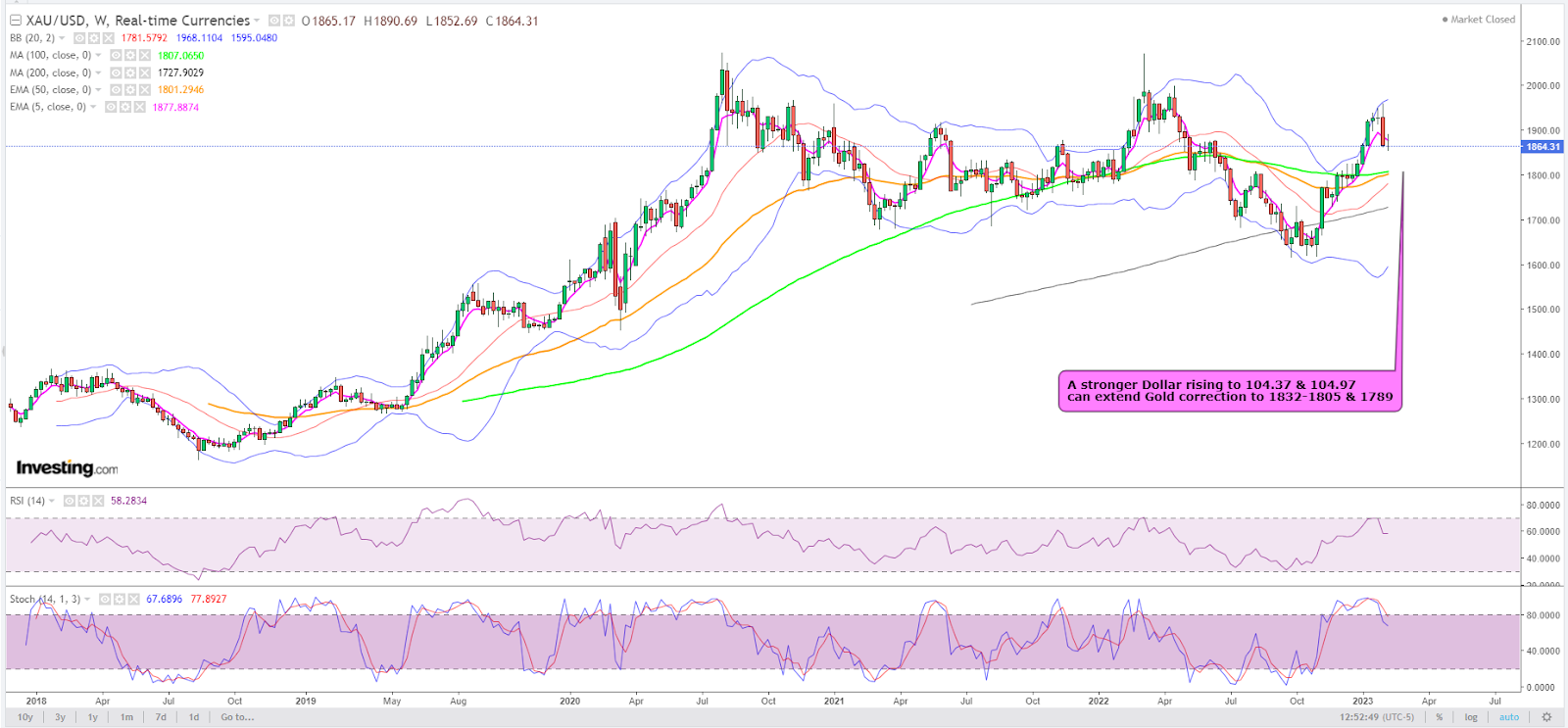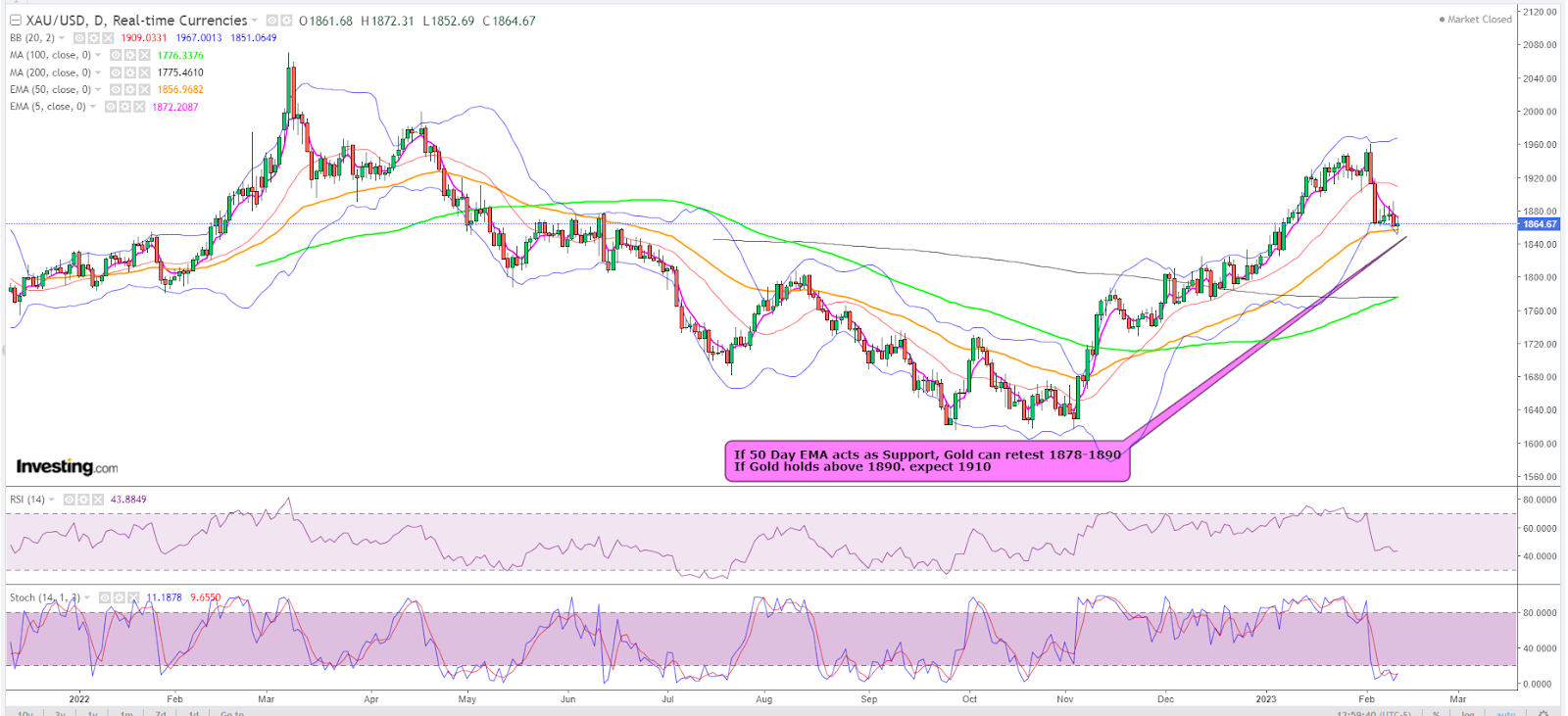HSBC downgrades Bloom Energy after significant rally
- A lower-than-expected CPI reading can bring gold some love this Valentine
- Yearly CPI growth is tipped to be lower, but core and monthly numbers could be up
- Gold needs to make a clear break above $1,900 to recapture upside, say analysts
Love is in the air! As the world readies to immerse itself in another celebration of Saint Valentine, those long gold are longing for some love, too — from inflation data due on Tuesday.
The Consumer Price Index will let us know how well the United States is distancing itself from inflation. The estrangement between the so-called CPI and price growth, called disinflation by the Federal Reserve, must grow in order to ensure that it’s the gold crowd that gets lucky on Feb. 14 — and not its nemesis who’s chasing the dollar.
On an annual basis, it’s looking rosy for believers in the yellow metal. The Consumer Price Index is forecast to have grown by just 6.2% year-on-year in January from a comparative 6.5% in December. Core CPI, which excludes volatile food and energy prices, is also glowing, with a yearly expansion of 5.5% from a previous 5.7%.
There’s a problem with these annual readings, though. Since base effects are likely to distort yearly measurements of price growth, market participants are likely to lean in equal measure — or perhaps more — on monthly Core CPI, which is forecast to have remained flat versus December’s 0.4% increase.
Such Core CPI market positioning suggests the potential for the dollar to become the toast of forex traders on Tuesday, especially if inflation sans food and energy prints a stronger-than-expected increase in January. On the other hand, a print at or below 0.3% could revive the narrative of a Fed seeking smaller interest rate hikes in 2023. That could boost gold and make the dollar toast of a different kind.
Core CPI isn’t the only number gold longs need to watch. In December, the services less energy services’ component of the CPI came in at +0.5%. Since this is the specific component of inflation that the Fed pays close attention to, a big increase in January, around 0.7% or 0.8%, could provide a boost to the dollar — even if the Core CPI comes in near the market expectation and vice versa.
Not too long ago, gold prices used to rise with inflation as investors bought the metal as a “hedge,” or store of value, against the dollar, which typically erodes in value when prices of goods and services go up. This was during normal times when good economic news was good for risk assets.
Now, good economic news — especially in US jobs and wages — is bad because it has the potential to make inflation hotter, prompting the Fed to dial up rates and hurt everything from stocks to gold and oil. Thus, gold’s positively correlated relationship with inflation has broken down and is expected to stay so until the Fed starts paying less attention to rates.
The Fed has increased rates by 450 basis points over the past year, taking them to a peak of 4.75% from just 0.25% after the COVID-19 outbreak in March 2020.
The central bank began with a modest 25 basis point hike in March 2022, dialing it upwards to 50 basis points the next month before embarking on four blockbuster 75-basis-point increases between June and November last year as annual inflation hit four-decade highs. The Fed slowed its pace of monetary tightening thereafter, returning to a 50-basis-point hike in December and a 25-basis-point increase this month.
However, runaway growth in non-farm payrolls in January — with 517,000 jobs added in the place of a forecast 185,000 versus December’s 260,000 — has raised questions on whether the Fed could continue tapering rate hikes.
For gold longs, unfortunately, the metal is caught in the crosshairs of the central bank’s fight against inflation. Every dollar and Treasury yield spike has become an opportunity to bid down gold.
Gold was initially tipped to hit above $2,000 an ounce in the first quarter of this year, reprising the rally seen in April 2022. Gold futures actually got 10-month highs at around $1,975 just before the release of the January jobs report on Feb. 1. It sank to below $1,830 since, before recovering to around $1,875.
The spot price of gold, which is more closely followed than futures by some traders, hovered at under $1,863 at the time of writing.
The dollar has had its own problems over the past few months as the Fed appeared to be on a dovish path with rate hikes. The Dollar Index Futures, which measures the greenback against six major currencies, fell from a two-decade high of 114.745 in September to a 10-month low of below 100.805 on Feb. 1. At the time of writing, the so-called DX was at just above 103.50.
Gold/dollar technical strategist Sunil Kumar Dixit of SKCharting.com said the US currency could reach new strength on the CPI data and drive down the spot price of gold accordingly. He adds:
“Stability for the DX at above 102.50 is bad news for gold bulls.
If DX manages to steadily hold above 103.65, it can quickly retest its previous swing high to 103.85 and challenge the 50-week EMA, or Exponential Moving Average of 104.01, followed by the five-month EMA of 104.37.”

Charts by SKCharting.com, with data powered by Investing.com
On a more granular chart level, DX has held above the 38.2% Fibonacci correction and is seen making a renewed attack on the 50-Day EMA of 103.65, supported by bullish RSI, or Relative Strength Index, and a positive Stochastics crossover on its daily chart said Dixit.
“We see a possibility of DX advancing towards 104 and perhaps 104.37, pushing gold lower towards $1,832-$1,828. If the dollar index goes parabolic above 104 and 104.37, we can witness a further rally towards 104.97, which may send gold to as low as $1,789.”
The last time gold traded below $1,800 was on Dec. 23, when it hit $1,798.90.
On the flip side, Dixit said there was also a fairly high probability zone where DX makes a bearish correction from 104.37 or 104.97 to a decline of below 102.50-102.30.
“This decline in DX may coincide with an end to gold’s correction and rebound from $1,789 towards 1900, to be further confirmed by a weekly close above $1,932,” he added.

Tammy Da Costa, another gold strategist, held a similar view, saying in a blog that ran on the DailyFX site:
“For gold bulls to regain confidence, a clear break of $1,900 and above $1,903 (38.2% retracement of the 2022 move) could drive prices back to the next barrier of resistance at $1930 before heading back toward $1,950.
On the contrary, a resurgence of bearish momentum below $1,871.6 could drive price action to the 50-day MA (moving average), holding as additional support at $1,859.4. The January low would then step in as the next target for sellers at $1,829.9, paving the way for further losses toward $1,800.”

On the heels of the CPI reading will be January’s retail sales numbers, due on Wednesday. While an important gauge in itself of how well consumers are holding up to inflationary pressure, retail sales will be secondary to Thursday’s Producer Index Index — one of the most important price indicators besides the CPI. This so-called PPI measures the average change over time in the selling prices received by domestic producers for their output — in this case, between December and January.
Also, on Thursday, there will be January Housing Starts and Building Permits data to show if the real estate market is continuing to improve from falling mortgage rates. Housing Starts are forecast to rebound and rise by 0.6% following December’s contraction of 1.4%. A negative print could hurt the dollar and help gold, though that impact is expected to be fleeting.
Thursday’s weekly initial jobless claims will also indicate how the labor market — the engine of US economic recovery from the coronavirus pandemic — is faring after January’s growth.
Of greater impact will be what Fed officials due to speak all week will say about rates, inflation, and the economy as they emerge to give their insights after the traditional two-week “information black-out” period preceding the central bank’s last rate hike on Feb. 1. New York Fed President John Williams, St. Louis Fed head James Bullard, Philadelphia Fed President Patrick Harker and Cleveland Fed head Loretta Mester are among those slotted to speak this week.
Their comments often make markets, including gold and dollar and the yield on the Treasury’s 10-year note, more volatile than they probably would be just tracking data releases.
Disclaimer: Barani Krishnan uses a range of views outside his own to bring diversity to his analysis of any market. For neutrality, he sometimes presents contrarian views and market variables. He does not hold positions in the commodities and securities he writes about.
